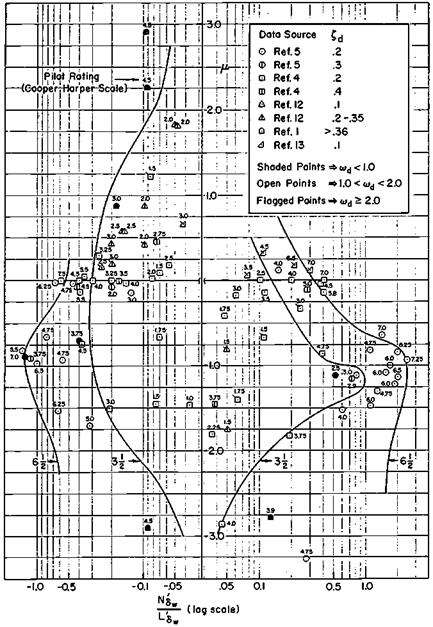Rapid Rolls to Steep Turns
Effective use of ailerons for rapid rolls to steep turns requires not only good roll response but also coordination, or the suppression of adverse yaw. The airplane’s lift vector should remain close to the airplane’s plane of symmetry during the roll and turn entry. The ball of the turn and slip indicator (see Chapter 15, Sec. 10.1) will then remain close to center, and the maneuver will be called coordinated. An alternate coordination condition is suppression of sideslip, which puts the velocity vector in the airplane’s plane of symmetry.
Starting with the 1943 Gilruth requirements for satisfactory flying qualities, coordination requirements were examined in rapid aileron rolls with the rudder held fixed at the initial trim position. The peak sideslip excursion and the phase angle of the Dutch roll component of the excursion were correlated with pilots’ ratings and used as the basis of U. S. Air Force coordination requirements.
More recent studies of tactical airplane roll response and steep turn entries have focused instead on the use of the rudder for coordination. Airplane transfer function theory has been applied, as in the case just described for pitch maneuvers. As in Figure 10.10, pilot ratings are compared with parameters derived from the roll and sideslip due to aileron and rudder transfer functions (Hoh and Ashkenas, 1977). Rudder deflection is assumed to be used in a coordinated fashion to hold the sideslip angle to zero in abrupt aileron rolls, as pilots are trained to do. The essence of the Hoh and Ashkenas method is a solution for the precise rudder cross-feed that accomplishes this, using linearized transfer functions.
|
Figure 10.10 Required rudder cross-feed to coordinate turn entry, a significant factor for airplanes with good Dutch roll characteristics. The amount and sense of rudder required isplotted on the abscissa. The ordinate і shows the required phasing of the rudder input. Rudder angle is sustained after initial input for positive values of і and reversed for negative values of і. The greatest pilot tolerance for required cross-feed occurs with і = —1.0, for which cross-feed fades to zero after the turn is established. (From Hoh and Ashkenas, Jour. of Aircraft, Feb. 1977) |
The solution is in two parts, magnitude and phasing. The phase dependence means that, depending on the details of the airplane’s lateral-directional dynamics, the required rudder deflections for coordination, or cross-feed, may increase or decrease after the initial rudder application.
The end result of the analysis shows a strong favorable effect for a particular required rudder cross-feed phasing. Pilots tolerate the largest amount of rudder angle cross-feed for the case in which the required rudder angle tapers off toward zero as the turn is established. Conversely, if the required rudder angle cross-feed either increases beyond the initial value or changes sign during the turn, pilot ratings suffer and smaller cross-feed levels are tolerated.
The cross-feed phasing parameter г that expresses all of this is derived from the ratios of the transfer function numerators of rudder to sideslip and aileron to sideslip. Excluding low (gravity) and high (direct force) frequency terms, the parameter г expresses the separation between simple zeros in these numerators. Positive values of г correspond to increasing rudder requirements during the turn and negative values to decreasing rudder requirements. The optimum case, in which the steady-state value in a turn goes to zero, corresponds to г = -1.0.














